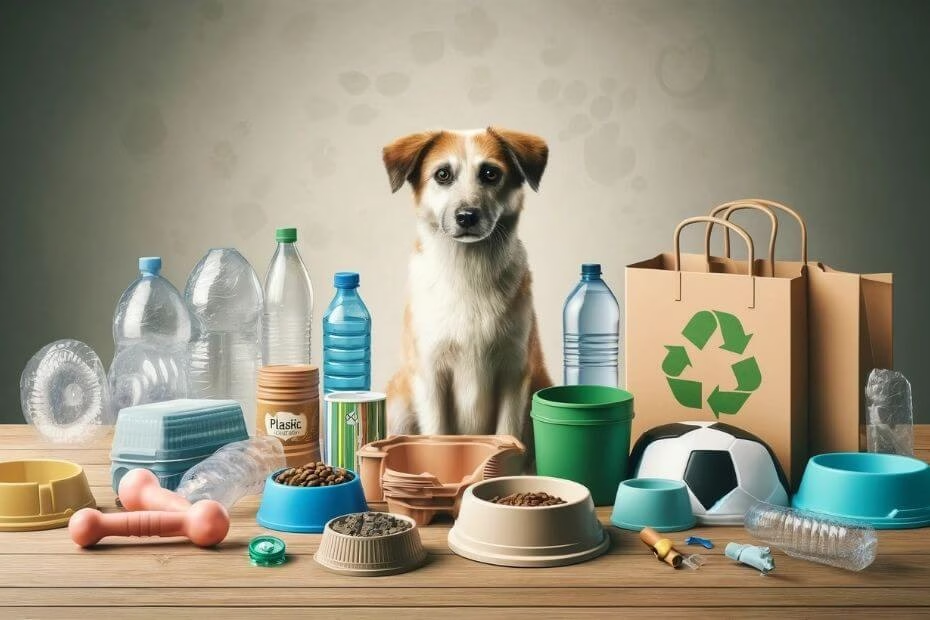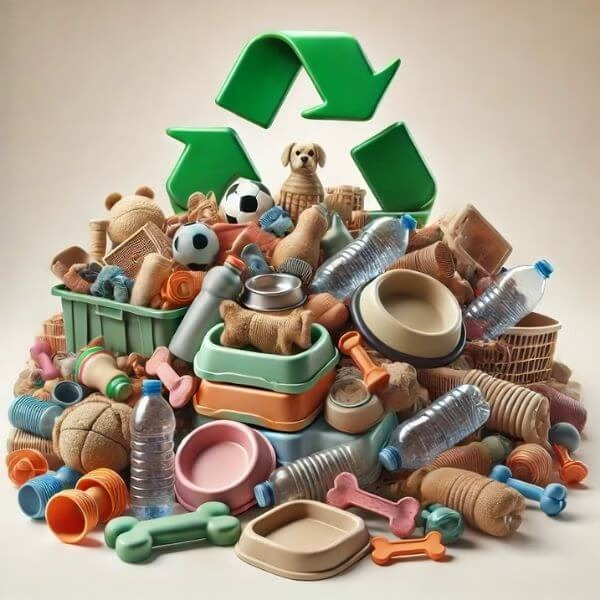Every time I grab a new bag of pet food or a toy for my cats, I can’t help but notice how much plastic is involved. It’s everywhere! From litter trays and food bags to toys and grooming tools, plastic is the go-to material in the pet care world.

The Environmental Toll of Plastic in Pet Care
And the problem? It’s a big one. First off, there’s the environmental side of things. Plastic production isn’t just about the waste it creates—it also requires massive amounts of energy and water, leading to greenhouse gas emissions that contribute to climate change. The environmental impact becomes even more significant when we consider the resources used to make every plastic bowl, toy, and bag.

Then there’s the waste. Whenever I toss a used-up plastic pet food bag, it could end up in a landfill—or worse, in the ocean. Since plastic takes hundreds of years to break down, that one little bag sticks around way longer than any of us would like.
The Hidden Risks of Plastic for Pets
Plastic doesn’t just harm the planet—it can mess with our pets, too. Our furry friends come into contact with plastic all the time, whether eating from a plastic bowl or chomping on a new toy. And here’s the kicker: plastics can release chemicals like BPA and phthalates, which aren’t exactly the healthiest things for pets.
Why does this matter? BPA is known to disrupt hormone function, and phthalates have been linked to developmental and reproductive issues in animals. Over time, exposure to these chemicals could lead to health problems ranging from mild skin irritation to more serious long-term effects.
You know that weird smell that some toys get after a few weeks? That’s plastics breaking down and releasing toxins, especially when exposed to heat or rough play. Those chemicals could lead to anything from digestive issues in dogs to skin irritation in cats. It’s a genuine concern when you want the best for your pets.
But switching to non-plastic alternatives can make a world of difference. Choosing safer options like stainless steel, ceramic, or glass can reduce these risks and give you peace of mind that your pets are safe.
Why Ditch Plastic Pet Bowls?
Using plastic bowls for your pets’ food and water might seem harmless, but it comes with risks. Chemicals like BPA can leach from scratched or worn-out plastic bowls and find their way into your pet’s meals. Over time, that’s not precisely the diet upgrade you want for them.
That’s why I’m a fan of switching to stainless steel, ceramic, or glass bowls. They’re durable, don’t leach chemicals, and are super easy to clean. Plus, they help keep bacteria at bay, which can be a hidden problem with older plastic bowls.
Making this switch is an easy win for your pet’s health and your peace of mind. After all, mealtime should be about wagging tails, not worrying about what’s in the bowl.
Cutting Down on Plastic in Your Pet Routine
Reducing the amount of plastic in your pet’s life doesn’t mean you have to do a complete 180 overnight. Start small and build from there. Look around at the plastic products you use daily—pet food containers, grooming tools, or even collars.
One simple change is opting for bulk or refillable pet food options. Many stores now let you bring your own containers, which cuts down on packaging waste. Or, look for brands using recyclable or biodegradable packaging—they’re making a difference, and you can too.
For grooming, try tools made from natural materials like bamboo instead of plastic. They’re eco-friendly and often last longer, which means less waste in the long run.
If you’re feeling creative, DIY toys from old fabrics can be a fun way to keep your pets entertained without adding to the plastic pile. Your pets will love the new playthings, and you’ll love knowing you’re doing your bit for the planet.
Dispose of Plastic Responsibly: If you already own plastic pet products, consider disposing of them responsibly. Some areas offer recycling programs for hard-to-recycle items like plastic pet food bags. Check with local facilities to see if recycling options are available, or look for ways to repurpose items around your home.
Eco-Friendly Materials to Look For
When choosing new pet products, keep an eye out for items made from sustainable materials. Here are some eco-friendly options:
- Natural Rubber: Ideal for durable chew toys, natural rubber is biodegradable and can handle rough play.
- Hemp or Jute: Used for collars and leashes, these materials are sturdy and sourced from renewable plants.
- Organic Cotton or Wool: Great for pet bedding, these materials are natural, non-toxic, and biodegradable.
By choosing these materials, you’re taking steps to minimize the environmental impact of your pet care routine.

Brands Leading the Way in Eco-Friendly Pet Care
Some pet care brands are taking notable steps to reduce plastic use and focus on sustainability. For instance, brands like Wild One and West Paw offer toys and accessories made from recycled materials or natural fibers. By supporting companies that prioritize eco-friendly practices, you’re helping your pet and encouraging more brands to make sustainable choices.
Going Plastic-Free for a Greener World
Choosing a plastic-free lifestyle for your pets isn’t just great for them—it’s also a win for the planet. Transitioning to eco-friendly products is all about making thoughtful choices that support sustainability.
Look for products made from renewable or recycled materials. Brands are stepping up with eco-friendly toys, bedding, and leashes, and it’s a great way to support companies that care about the environment.
Long-term change means keeping up the habit. Whether it’s using biodegradable poop bags or switching to natural fiber pet beds, every little bit helps. Each small choice is a step toward a cleaner planet.
Support Change in the Pet Care Industry
Your choices as a consumer can drive change. Support pet brands that prioritize sustainability, and consider contacting your favorite brands to encourage eco-friendly practices. The demand for greener pet care options is growing, and your voice can help influence the industry to reduce plastic and embrace sustainable materials.
By making these changes, you’re not just helping your pets—you’re building a better world for all of us. And that’s a win-win in my book!

